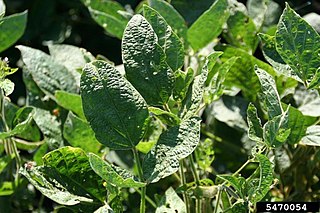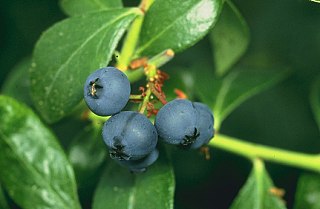Barley yellow dwarf (BYD) is a plant disease caused by the barley yellow dwarf virus (BYDV), and is the most widely distributed viral disease of cereals. It affects the economically important crop species barley, oats, wheat, maize, triticale and rice.

Plum pox, also known as sharka, is the most devastating viral disease of stone fruit from the genus Prunus. The disease is caused by the plum pox virus (PPV), and the different strains may infect a variety of stone fruit species including peaches, apricots, plums, nectarine, almonds, and sweet and tart cherries. Wild and ornamental species of Prunus may also become infected by some strains of the virus.

Potato leafroll virus (PLRV) is a member of the genus Polerovirus and family Solemoviridae. The phloem limited positive sense RNA virus infects potatoes and other members of the family Solanaceae. PLRV was first described by Quanjer et al. in 1916. PLRV is transmitted by aphids, primarily the green peach aphid, Myzus persicae. PLRV is one of the most important potato viruses worldwide but particularly devastating in countries with limited resources and management. It can be responsible for individual plant yield losses of over 50%. One estimate suggests that PLRV is responsible for an annual global yield loss of 20 million tons. Symptoms include chlorosis, necrosis and leaf curling.
Citrus tristeza virus (CTV) is a viral species of the genus Closterovirus that causes the most economically damaging disease to its namesake plant genus, Citrus. The disease has led to the death of millions of Citrus trees all over the world and has rendered millions of others useless for production. Farmers in Brazil and other South American countries gave it the name "tristeza", meaning sadness in Portuguese and Spanish, referring to the devastation produced by the disease in the 1930s. The virus is transmitted most efficiently by the brown citrus aphid.

Papaya ringspot virus (PRSV) is a pathogenic plant virus in the genus Potyvirus and the virus family Potyviridae which primarily infects the papaya tree.
Asparagus virus 1 (AV-1) is one of the nine known viruses that affects asparagus plants. It is in the Potyviridae family. Initially reported by G. L Hein in 1960, it is a member of the genus Potyvirus and causes no distinct symptoms in asparagus plants. The only known plant that can get AV-1 is asparagus plants. It is spread by aphids vectors, which means that aphids do not cause the AV-1, but they do spread it.

Banana bunchy top virus (BBTV) is a plant pathogenic virus of the family Nanoviridae known for infecting banana plants and other crops. It is aphid transmitted.

Cucumber mosaic virus (CMV) is a plant pathogenic virus in the family Bromoviridae. This virus has a worldwide distribution and a very wide host range. In fact it has the reputation of having the widest host range of any known plant virus. It can be transmitted from plant to plant both mechanically by sap and by aphids in a stylet-borne fashion. It can also be transmitted in seeds and by the parasitic weeds, Cuscuta sp. (dodder).
Potato virus Y (PVY) is a plant pathogenic virus of the family Potyviridae, and one of the most important plant viruses affecting potato production.

Tobacco rattle virus (TRV) is a pathogenic plant virus. Over 400 species of plants from 50 families are susceptible to infection.

Soybean mosaic virus (SMV) is a member of the plant virus genus Potyvirus. It infects mainly plants belonging to the family Fabaceae but has also been found infecting other economically important crops. SMV is the cause of soybean mosaic disease that occurs in all the soybean productions areas of the world. Soybean is one of the most important sources of edible oil and proteins and pathogenic infections are responsible for annual yield losses of about $4 billion in the United States. Among these pathogens, SMV is the most important and prevalent viral pathogen in soybean production worldwide. It causes yield reductions of about 8% to 35% but losses as high as 94% have been reported.

Strawberry vein banding virus (SVBV) is a plant pathogenic virus and a member of the family Caulimoviridae.

Orthotospovirus is a genus of negative-strand RNA viruses, in the family Tospoviridae of the order Bunyavirales, which infects plants. Tospoviruses take their name from the species Tomato spotted wilt orthotospovirus (TSWV) which was discovered in Australia in 1919. TSWV remained the only known member of the family until the early 1990s when genetic characterisation of plant viruses became more common. There are now at least twenty species in the genus with more being discovered on a regular basis. Member viruses infect over eight hundred plant species from 82 different families.

Blueberries are a widely distributed and widespread group of perennial flowering plants with blue or purple berries. They are classified in the section Cyanococcus within the genus Vaccinium. Vaccinium also includes cranberries, bilberries, huckleberries and Madeira blueberries. Commercial blueberries—both wild (lowbush) and cultivated (highbush)—are all native to North America. The highbush varieties were introduced into Europe during the 1930s.
Commelina mosaic virus (CoMV) is a plant pathogenic virus in the genus Potyvirus and the virus family Potyviridae. Like other members of the Potyvirus genus, CoMV is a monopartite strand of positive-sense, single-stranded RNA surrounded by a capsid made for a single viral encoded protein. The virus is a filamentous particle that measures about 707-808 nm in length. This virus is transmitted by two species of aphids, Myzus persicae and Aphis gossypii, and by mechanical inoculation.
The Blueberry leaf mottle virus (BLMV) is a Nepovirus that was first discovered in Michigan in 1977. It has also appeared in New York, eastern Canada, Bulgaria, Hungary, and Portugal.
Blueberry shock virus (BlShV) is an Ilarvirus belonging to the Bromoviridae family. The Bromoviridae family contains single-stranded, positive-sense RNA viruses. Virus particles are icosahedral and 30 nm in diameter. Blueberry shock virus causes shock of blueberries in Oregon, Washington, and British Columbia. It gets its name because plants are shocked by the initial infection, meaning the flowers and foliage blight and wilt in the early spring, right when the plant is in full bloom. BIShV was first discovered in a blueberry field containing highbush blueberry in Washington in 1991. It continued to spread to Oregon, Washington and British Columbia since that time. In 2009, the disease was found in a western Michigan field, and may be preset in Pennsylvania as of 2011. Since its discovery, eradication is in progress to eliminate the disease and reduce loss of yield from it.
Carrot virus Y (CarVY) is a (+)ss-RNA virus that affects crops of the carrot family (Apiaceae), such as carrots, anise, chervil, coriander, cumin, dill and parsnip. Carrots are the only known crop to be infected in the field. Infection by the virus leads to deformed roots and discolored or mottled leaves. The virus is spread through insect vectors, and is currently only found in Australia.













